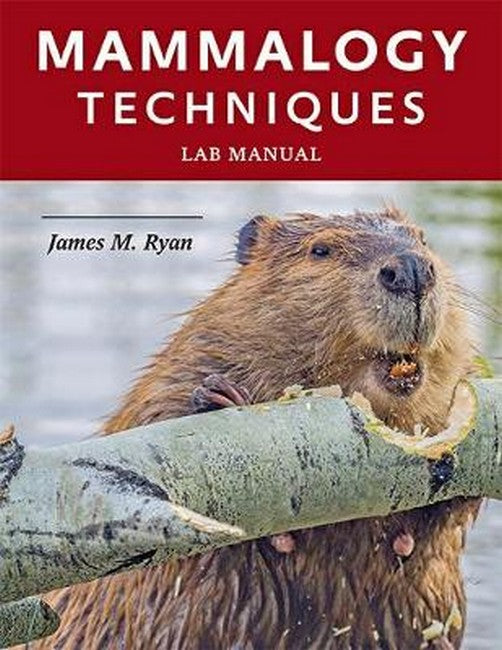Acknowledgments
Chapter 1. Introduction
Background
How to Use This Manual
R Statistical Environment
Chapter 2. Mammal Skulls
Background
Bones and Features of the Skull
Variation in Mammalian Skulls
Zygomatic Morphology in Rodents
Telescoping in Cetaceans
Skull Measurements
Exercise 1: The Nuts and Bolts
Exercise 2: Dichotomous Keys of Skulls
Exercise 3: Mystery Mammal Skull
Appendix
Chapter 3. Mammalian Teeth
Background
Internal Structure
Kinds of Teeth
Occlusal Patterns and Cusps
Types of Teeth and Diet
Tooth Replacement
Dental Formulas
Exercise 1: Dental Terminology
Exercise 2: Dental Key to North American Mammals
Chapter 4. Phylogeny Reconstruction
Background
How Do We Construct Phylogenetic Trees?
Exercise 1: Manual Sequence Alignment
Exercise 2: Sequence Alignment Using Computers
Exercise 3: Exploring the Open Tree of Life
Chapter 5. Keeping a Field Notebook
Background
Why Keep a Field Notebook?
Elements of a Field Journal
Two-Part Field Notes
Grinnell Method
Exercise 1: Locality Information Using Topo Maps
Exercise 2: Taking Field Notes
Chapter 6. Livetrapping Small Mammals
Background
Live Traps
Exercise 1: Setting up a Livetrapping Grid
Exercise 2: Checking Traps and Collecting Capture Data
Handling Captured Mammals
Marking Mammals
Sexing and Aging Small Mammals
Measuring Small Mammals
Exercise 3: Data Collection and Analysis
Appendix
Chapter 7. Specimen Preparation
Why Collect Specimens?
Documenting Specimens
Exercise 1: Taking Standard Measurements
Recording Reproductive Data
Preparing Museum Specimens
Exercise 2: Preparing a Museum Study Skin
Exercise 3: Preparing Skulls
Exercise 4: Preparing Skeletons
Chapter 8. Field Collecting and Preserving Mammalian Parasites
Background
Exercise 1: Making a Blood Smear
Exercise 2: Collecting Ectoparasites
Exercise 3: Collecting Endoparasites
Exercise 4: Preliminary Ectoparasite Identification
Exercise 5: Ectoparasite Population Ecology
Chapter 9. Mark-Recapture Studies
Background
Lincoln-Petersen Method
Schnabel Model
Jolly-Seber Model
Exercise 1: Single Mark-Recapture (Lincoln-Petersen Method)
Exercise 2: The Schnabel Method
Exercise 3: The Jolly-Seber Model Using Excel
Appendix
Chapter 10. Using Software for Mark-Recapture Data
Background
Capture Probability and Encounter Histories
Capture Models
Exercise 1: Using the Program CAPTURE
Exercise 2: Tigers in India
Exercise 3: Mark-Recapture Sampling Using Rcapture
Appendix A
Appendix B
Chapter 11. Transects: Using Distance Sampling
Background
Indirect Data
Field Procedures
Indirect Transect Surveys
Exercise 1: Conducting Deer Pellet Transect Surveys
Exercise 2: Dung Counts Using PELLET
Exercise 3: Data Analysis Using Rdistance in RStudio
Chapter 12. Camera Trapping
Background
Camera Selection
Survey Design
Exercise 1: A Camera-Trap Field Study
Data Analysis
Exercise 2: Data Analysis from Camera-Trap Studies
Exercise 3: Using camtrapR to Analyze Camera-Trap Data
Chapter 13. Radio Tracking
Background
Types of Radio-Telemetry Studies
Radio-Telemetry Equipment
Locating Animals
Exercise 1: Locating Animals by Homing
Exercise 2: Locating Animals via Triangulation
Exercise 3: Data Analysis: The Minimum Convex Polygon
Exercise 4: Data Analysis Using sigloc in RStudio
Exercise 5: Using adehabitatHR in RStudio
Chapter 14. GPS Tracking Using GPSVisualizer and MoveBank
Background
Exercise 1: Tracking Grizzly Bears with GPSVisualizer
Exercise 2: Exploring MoveBank Data
Chapter 15. Recording and Analyzing Mammal Sounds
Background
Equipment for Recording Sounds
Software for Analyzing Sounds
Interpreting a Sonogram
Exercise 1: Field Recording
Exercise 2: Sound Analysis Using Audacity
Exercise 3: Playback Experiments Using Alarm Calls
Chapter 16. Quantifying Mammalian Behavior
Background
Avoiding Common Problems
Exercise 1: Building an Ethogram
Exercise 2: Sampling Behaviors
Exercise 3: Creating a Time Budget
Exercise 4: Creating a Transition Diagram
Exercise 5: Creating a Dominance Hierarchy
Exercise 6: Dominance Hierarchy Analysis
Exercise 7: Social Network Analysis Using igraph
Chapter 17. Optimal Foraging Behavior
Background
Foraging in Patches
Exercise 1: Profitability and Prey Choice
Exercise 2: Foraging in Patches
Exercise 3: Foraging with Risk
Appendix
Chapter 18. Field Karyotyping
Background
What Is a Karyotype?
How Are Karyotypes Produced?
Exercise 1: Field Karyotyping
Exercise 2: G-banding Chromosomes with Trypsin
Exercise 3: Analyzing the Karyotype Manually
Exercise 4: Measuring Chromosomes with ImageJ Software
Appendix A
Appendix B
Chapter 19. Non-invasive Hair Sampling
Background
Hair Morphology
Exercise 1: Field Methods for Collecting Hairs
Exercise 2: Creating a Hair Reference Collection
Exercise 3: Quantifying Hair Structure Using ImageJ Software
Exercise 4: Extracting DNA from Hair Samples
Instructor Resources
General Field Equipment Sources
Mammalian Skulls and Skeletons
Biotelemetry Resources
Camera Traps
Sound Recording
Ultrasound Recording Equipment (Bat Detectors)
Glossary
Bibliography
Index
Request Academic Copy
Please copy the ISBN for submitting review copy form
Description
""The content makes for a book of such a range of mammal study methods it is difficult to think all that can be in just 179 pages.""

